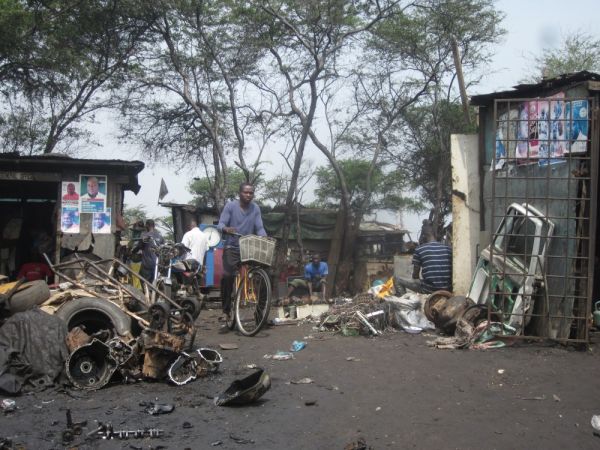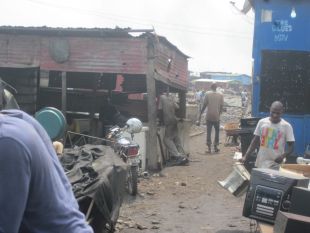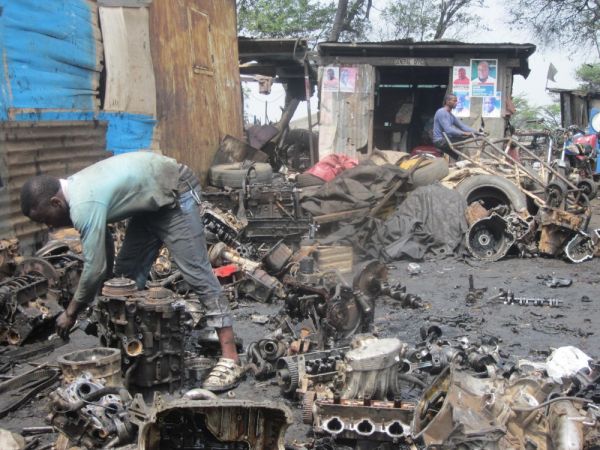Where Your Old Cell Phone Is Turned Into Cash

Accra is one of the world’s leading destinations for e-waste, most of which is processed in Agogbloshie. Photo credit: Sharon Benzoni
Among the first things that strike you as you turn off Ring Road toward Korle Lagoon and Agogbloshie are the onions. Trucks of onions, rows of onions, signboards with whimsical drawings of sprouted onions. The pungent odor of onions. Giant sacks of onions on men’s backs, forcing them to double over. It seems as though every onion that enters Accra must first make a stop here.
A few hundred meters further down the road the smell of the lagoon, stained inky black, overtakes the smell of onions. On the left is the smaller yam market, with the long brown roots stacked in neat little teepees.
But it’s not the onion market or the yam market that form the backbone of this local economy: It’s your old Nokia flip phone with the Kelly Clarkson ringtone. This is one of the biggest global destinations for e-waste. Last week, when I wrote about this Accra slum – known variously as Agogbloshie, Old Fadama and “Sodom and Gomorrah” – I detailed its innovative savings and credit association. This is the other side of it: an informal recycling industry that’s profitable yet environmentally toxic.

Electronics are shipped here from Europe and North America, where their raw materials are stripped and exported. Photo credit: Sharon Benzoni
Beyond the onions and the yams, behind a row of shops and vendors, the land slopes upward into a hill of rubbish. It is the morning after the first rain in weeks; little puddles have formed and the sawdust, soil and trash have congealed into a murky sludge. Refrigerators are lined up, car doors lean against shacks, old PC monitors form battered, beige walls. The detritus of the most sophisticated products of our technological era lie in heaps. The sound of metal pounding against metal creates a kind of pinging music.
I’m visiting this part of Agogbloshie, by chance, with a group of NYU Dubai students accompanied by a professor from New York. The issue of e-waste here has become such a world-famous case study that it generates an odd sort of slum tourism for human-rights activists, social documentarians and students of development. We are led to a small covered area where we sit on a low wooden bench. A young man, noticing that my feet are touching the muddy water, places coconut husks underneath my inadequate sandals.
The local chairman greets us, sitting on an old bench seat torn from a van. The people he represents form a critical part of an elaborate and flexible ecosystem that extends around the world. In 2009, Ghana imported 215,000 tons of electronic equipment, about 70 percent of which was secondhand. Much of it is refurbished, its life extended six months, maybe a year. Then it is collected, mainly by young boys – some of them very young — and brought to sites like Agogbloshie, where it is disassembled and sorted, the valuable parts sold to dealers. Some is processed into value-added products locally, but most is re-exported in a relatively raw form. An estimated 280,000 tons of e-waste entered this system in 2009.
The place is undeniably grim. Workers look exhausted, their clothing covered in a film of oil. One 17-year-old boy breaking apart an axle lifts his mallet with the heavy dullness of someone who has repeated this action many thousands of times and does not expect that to change anytime soon. The chairman explained that tires are burned to get to the copper wires inside them. Once the valuable materials have been extracted, the discards are dumped or burned. These workers endure long days, ten to twelve hours of exposure to heavy metals, noxious chemicals and particulate matter. A Greenpeace assessment revealed a dizzying list of contaminants in the soil: lead, mercury, PCBs, phtalates, barium, antimony. The workers know the risks, the chairman says, in part because of the work of external organizations in documenting and communicating with them, but they have few alternatives.
Many of the workers are migrants from rural areas, especially in the north, whose farming skills have no application in the city. This work, though hard and dangerous, offers a steady income, an attractive alternative to the vagaries of weather and a changing climate in the arid north. Children as young as five are reported to be involved in the collection and sorting process. A group of young street children I spoke with last year reported that they rise every morning before dawn to collect these products to get their daily food money.

While profitable, the e-waste industry also creates health and environmental problems. Photo credit: Sharon Benzoni
Despite the known hazards, the e-waste system is robust. The global demand for the gold, lead, aluminum, copper and other valuable materials is high. Dealers and exporters make their share. The workers at Agogbloshie have their small businesses, the piles of waste they slowly acquire from informal collectors. The few formal collectors with waste-processing facilities cannot afford to pay for the materials they collect, but the young people who roam the streets collecting e-waste do offer money. As the chairman explains, “Most of the big men in the bungalows have also learned that you can still sell your computers.” In a country where everyone is hustling, economic incentives nearly always win.
From an environmental perspective, the Agogbloshie recycling system offers many contradictions. Locally, the negative effects are obvious. As recently as the 1980s, the Korle Lagoon and Odaw River comprised a local fishing ground. Now the lagoon is dead, heavy metals and chemical contaminants are found in its soil and surface. And yet, the system of refurbishing and finally recycling electronic products extends the utility and life of throwaways from Europe and North America, and makes use of valuable materials that would otherwise be mined in other places. Then again, the fuel consumed importing and then exporting the materials complicates the matter. The algebra of environmental justice is far from clear.
Furthermore, e-waste is an indicator of Ghana’s many development gains. Rising demand for these products reflects the country’s growing wealth. The government has made technology access and literacy the center of much of its development policy. Secondhand products, an affordable alternative to expensive new imports, give many more people access to information technology.
Politically, the Agogbloshie e-waste site is another problem. Government officials tend to focus on the eyesore and the pollution, the illegal use of government land. They recently announced, yet again, a planned eviction to move forward on an ecological restoration campaign. But the e-waste will still be generated. There will still be hundreds of thousands of people whose livelihoods depend on collecting its valuable components. There will still be 45 percent unemployment, exclusively high housing prices, and a lack of access to quality and affordable education. One government minister, at least, has pointed out the potential economic and social benefits of a better-managed e-waste system. And recently appointed minister Nana Oye Lithur, a prominent human-rights lawyer, has been outspoken in her support of the rights of residents of the slum. Recently elected President John Mahama, a Northerner himself, made a recent statement at Old Fadama that indicated his support for the residents. Ghanaians are resourceful people. Even if the eviction proceeds over the efforts of residents and clamor of human-rights organizations, the system could very well re-organize itself elsewhere in slightly altered form.









